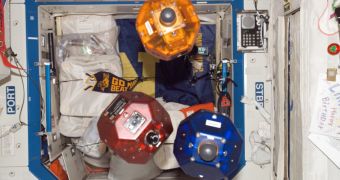The European Space Agency (ESA) is launching one of the most interesting competitions it ever sponsored. It is currently asking students to develop control programs for a series of miniature satellites that are already being used aboard the International Space Station (ISS).
According to officials at the organization, the Zero Robotics competition – whose name hints at the fact that the robots operate in zero gravity – is all about intelligence, brains and ability. Participants need to do a better job at controlling the satellites than ESA experts currently do.
The devices targeted in this research are called Synchronized Position Hold, Engage, Reorient, Experimental Satellites (SPHERES). The spherical instruments, which are about the size of bowling balls, are used for a variety of tests and tasks aboard the ISS.
The data they collect are used by experts to assess the performances of spacecraft that must carry out autonomous rendezvous and docking with the ISS. There is no room for error in these maneuvers, and so the telemetry needs to be perfectly grounded in reality, experts say.
Each SPHERES has its own power, propulsion, computers and navigation, and are therefore considered to be self-contained structures in their own right. Three such instruments are currently in use in orbit.
“The Zero Robotics competition was created in 2009 by the Space Systems Laboratory of the renowned US Massachusetts Institute of Technology (MIT). If you think it sounds simple, we encourage you to try!” ESA experts say in a press release accompanying the announcement.
One of the most interesting applications for data obtained via the SPHERES is the creation of spacecraft that can fly in formation, under specific configurations (triangles, squares, rectangles and so on).
Maneuvers associated with orbital docking and satellite servicing might also become easier and safer thanks to these data, ESA believes. Understandably, the programs that control SPHERES need to be up to the task, hence the new competition.
The agency announces that the contest will feature three phases, each of which will be more complex and difficult to complete than the one before. After the third, a team will be declared the winner.
“The first step is a computer simulation of the game played on a server at MIT This will reveal any major mistakes in the coding,” the press release explains.
“The next phase is an online game on a 2D platform using real Spheres at MIT's flatbed facility. This is an opportunity for teams to test their algorithms under realistic conditions,” the document adds.
“The final phase is on the Station, where the programs from the winning groups will be uploaded and run in the satellites,” ESA experts conclude.

 14 DAY TRIAL //
14 DAY TRIAL //